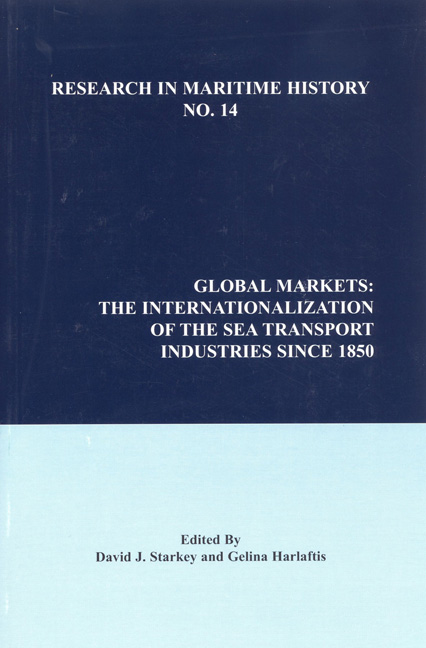Book contents
- Frontmatter
- Contents
- About the Editors
- Contributors
- Introduction
- “International Freight Markets in the 1830s and 1840s: The Experience of a Major Finnish Shipowner”
- “The First (and Very Secret) International Steamship Cartel, 1850-1856”
- “Competition or Co-operation in the Global Shipping Industry: The Origins and Impact of the Conference System for British Shipowners before 1914”
- “National Alliances and Global Webs: The Internationalization of Japanese Shipping”
- “Dutch Sea Transport in Transition: The German Hinterland as Catalyst, 1850-1914”
- “The Expansion of American Interests in Transatlantic Commerce and Trade, 1865-1893”
- “The Expansion of Japan's Shipping Interests before the Sino-Japanese War”
- “Cooperation and Reorganization on the North-South Routes from Japan in the Interwar Period”
- “The Global Communications Industry and Its Impact on International Shipping before 1914”
- “The Nineteenth-Century Roots of Globalization: Some Technological Considerations”
- “The Global Fish Market: Internationalization and Globalization, 1880-1997”
- “Convergence or National Styles? The Japanese Challenge to the British-Norwegian Hegemony in the Twentieth-Century Whaling Industry”
- “International Trends and Greek Shipping: The Business Strategy of Demetrios Moraitis, 1893-1908”
- “Organizational and Managerial Patterns of Greek- Owned Shipping Enterprises and the Internationalization Process from the Internar Period to 1990”
- “Internationalization and the Collapse of British Shipbuilding, 1945-1973”
- “Globalization and International Competitiveness: The Experience of the Japanese Shipping Industry since the 1960s”
- “Containerization and the Globalization of Liner Shipping“
“Competition or Co-operation in the Global Shipping Industry: The Origins and Impact of the Conference System for British Shipowners before 1914”
- Frontmatter
- Contents
- About the Editors
- Contributors
- Introduction
- “International Freight Markets in the 1830s and 1840s: The Experience of a Major Finnish Shipowner”
- “The First (and Very Secret) International Steamship Cartel, 1850-1856”
- “Competition or Co-operation in the Global Shipping Industry: The Origins and Impact of the Conference System for British Shipowners before 1914”
- “National Alliances and Global Webs: The Internationalization of Japanese Shipping”
- “Dutch Sea Transport in Transition: The German Hinterland as Catalyst, 1850-1914”
- “The Expansion of American Interests in Transatlantic Commerce and Trade, 1865-1893”
- “The Expansion of Japan's Shipping Interests before the Sino-Japanese War”
- “Cooperation and Reorganization on the North-South Routes from Japan in the Interwar Period”
- “The Global Communications Industry and Its Impact on International Shipping before 1914”
- “The Nineteenth-Century Roots of Globalization: Some Technological Considerations”
- “The Global Fish Market: Internationalization and Globalization, 1880-1997”
- “Convergence or National Styles? The Japanese Challenge to the British-Norwegian Hegemony in the Twentieth-Century Whaling Industry”
- “International Trends and Greek Shipping: The Business Strategy of Demetrios Moraitis, 1893-1908”
- “Organizational and Managerial Patterns of Greek- Owned Shipping Enterprises and the Internationalization Process from the Internar Period to 1990”
- “Internationalization and the Collapse of British Shipbuilding, 1945-1973”
- “Globalization and International Competitiveness: The Experience of the Japanese Shipping Industry since the 1960s”
- “Containerization and the Globalization of Liner Shipping“
Summary
“Globalisation,” Martin Wolf wrote recently in the Financial Times, “is a word that now leaps readily to every tongue. Like the idea or loathe it, few deny its existence or understate its significance.” Yet the idea of freer trade in goods and services combined with largely unfettered capital movements is not really very new. Economic historians may indeed be as familiar with the concept in a much earlier context as in a late twentieth-century one. From about the middle of the nineteenth century regional economic networks began to coalesce to create not just international groupings in which several countries participated, but globalization whereby the world economy functioned more or less as a whole. Production expanded under conditions of comparative cost advantage so that exports represented nearly ten percent of the world's output. Moreover, during the second half of the nineteenth century most countries had in practice adopted an internationally acceptable system of fixed exchange rates through the gold standard. In addition, net overseas lending and borrowing before 1914 was a much higher fraction of national income than it is today and the first multinational companies had begun to generate transactions within the international economy. And, unlike today, emigration remained at a buoyant level as labour moved more or less freely between countries. Economic activity was clearly multilateral in the decades before the First World War rather than bilateral. What brought all this about?
Today, information technology lies behind the growing integration of the global economy but 150 years ago the permissive technology which underpinned the trend towards globalization was that which lowered the cost of transport and communication. Globalization occurred before 1914 because transport became a fraction of the end user price of products. It was now worthwhile to import into Europe wheat and meat from as far away as Argentina or Australia because lower transport charges had removed the protection which distance had earlier given to European farmers. Improved steamships and the compound engine, as well as railroads, spread rapidly throughout the globe. In addition, the telegraph and the cable transformed information flows and made them accessible to all. If technological change made globalization feasible, then liberalization made it happen.
- Type
- Chapter
- Information
- Global MarketsThe Internationalization of The Sea Transport Industries Since 1850, pp. 53 - 80Publisher: Liverpool University PressPrint publication year: 1998



